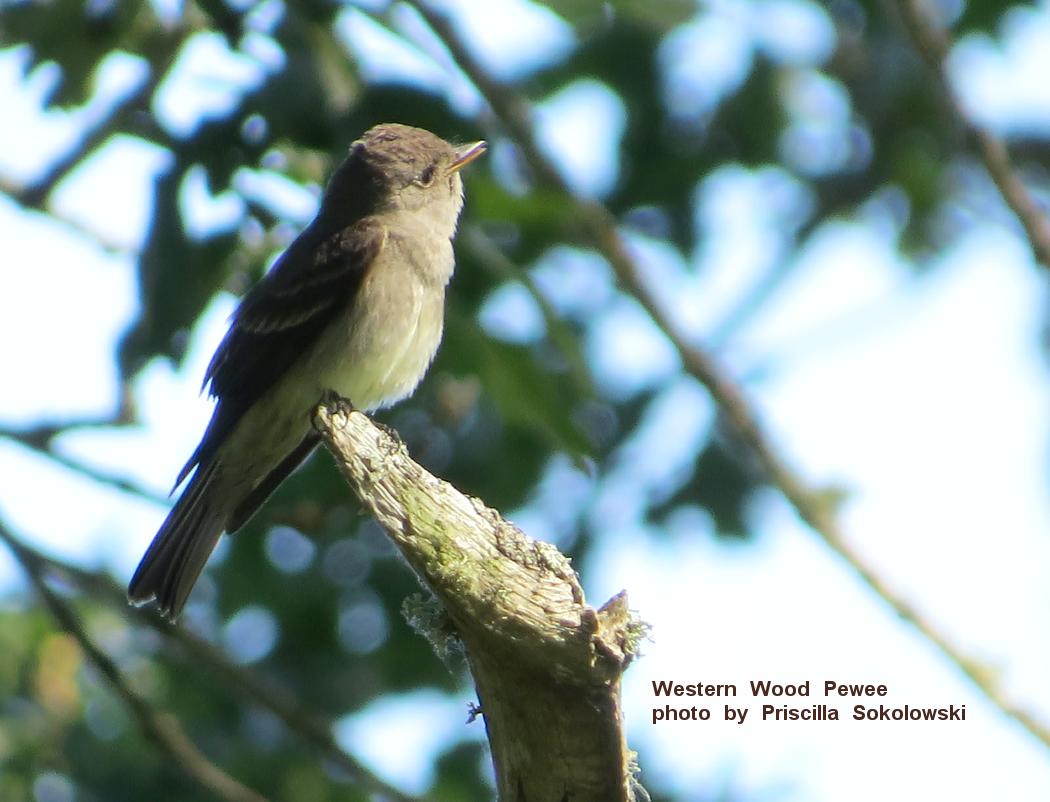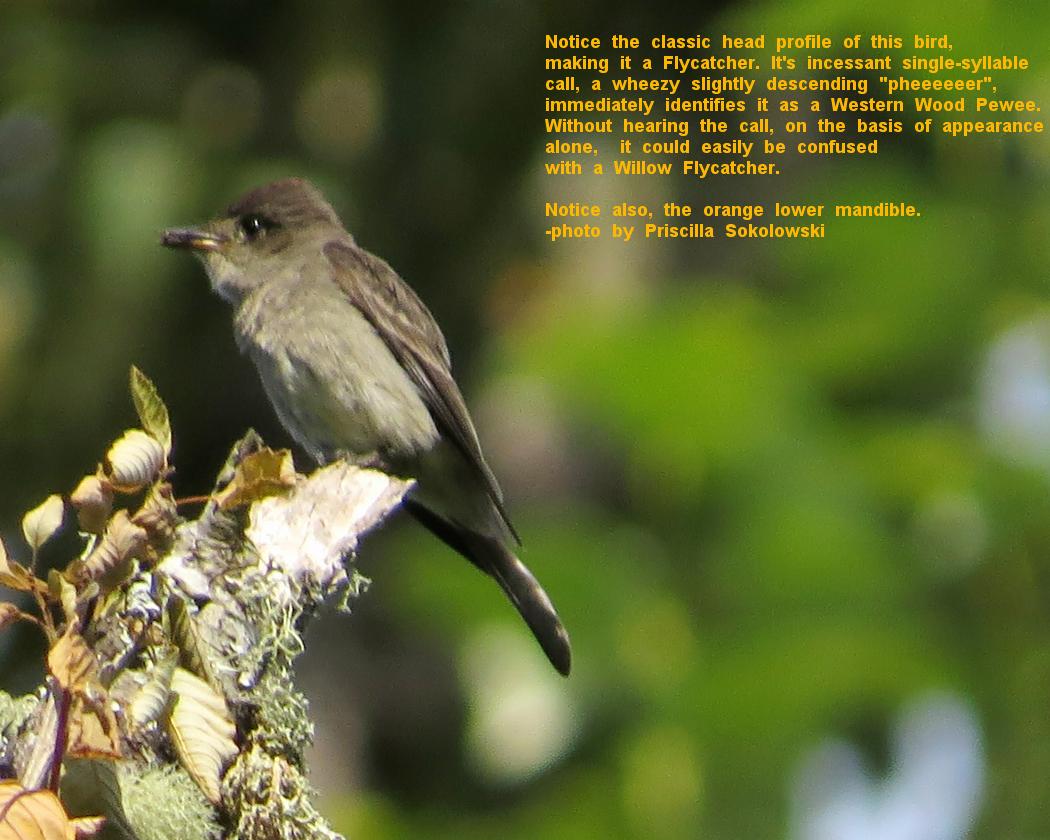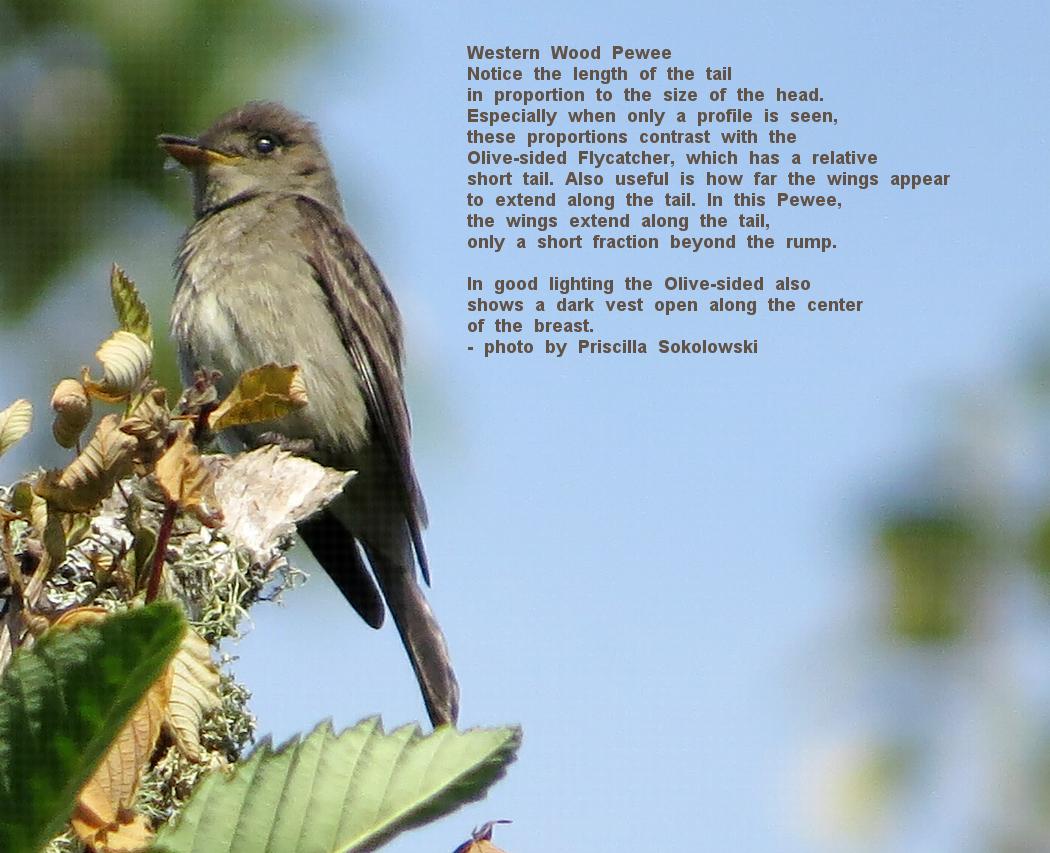A solid dozen or more birders showed up for our first bird walk of the summer.
Bill and Christy generously shared their spotting scope with all of us,
making it possible for nearly everyone to get a good look at some of the more distant birds.
Jody had suggested for our first trip, that we go to the Hansen See-Sil area,
which is BLM or Army Corp of Engineers land. The access point begins
just a short distance east of the usual Royal Ave parking lot and proceeds north
into what is known by local birders as the "Grasshopper Sparrow" fields.
A month or so ago we had a biologist from Fern Ridge give a presentation to BOGS
at which he said Grasshopper Sparrows have been declining over the decades because
they reside in Oak-Savannah habitat, which has become increasingly rare
in the Willamette Valley. He also said our local Grasshopper Sparrow colony
might be the largest remaining one in the valley. I don't know if anyone in our group
on this walk had seen Grasshopper Sparrows before, but I can tell you that I had not,
nor had Jody, Donna, or Marylee, and I think neither had Jen or Janet.
Needless to say, this bird took its place as our primary goal
as we began heading north into the fields.

Before we began walking, we were hearing Meadowlarks in the fields.
I think Janet also heard a Mourning Dove, before Jody, Doris and I arrived.
In a short time we saw a brilliant male American Goldfinch, which Don photographed.
In the distance a raptor was spotted on a low fence post. When it flew
a white tell-tale rump patch identified it as a Northern Harrier.
A Meadowlarks made itself visible up on top of a tall post.
It was some distance away but in binoculars it had that familiar stocky,
rather large bird look, and that leaning forward posture one often sees.
We could see it was singing and could hear its song, so the ID was pretty definite.

We had only been walking not more than 20 minutes when a small sparrow was seen
at the top of a 3 foot high plant with no obvious vegetation.
Some of us were hearing a thin buzzy call faintly up ahead. The Grasshopper sparrow
got its name from its thin buzzy call, which resembles the sound of a grasshopper.
Our photos showed our bird in the act of singing. We got closer to it
and confirmed that it had no streaking on throat, breast or flanks,
and it did have a yellow tinge on its belly which could be seen at times.


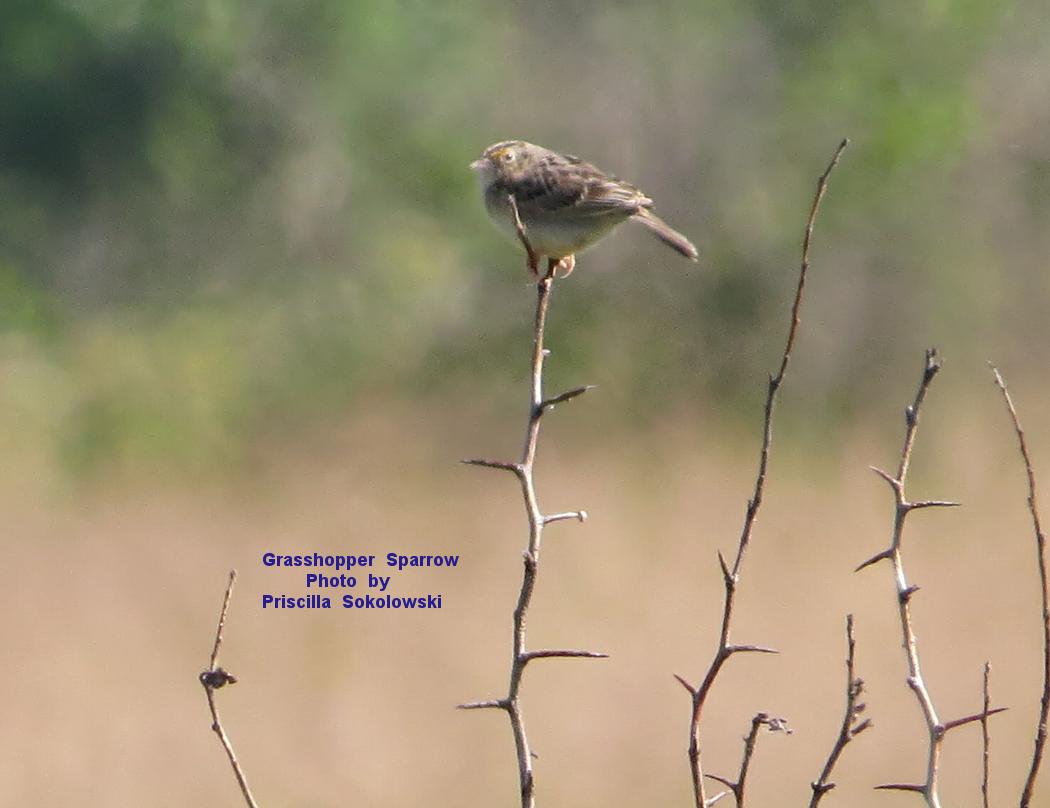



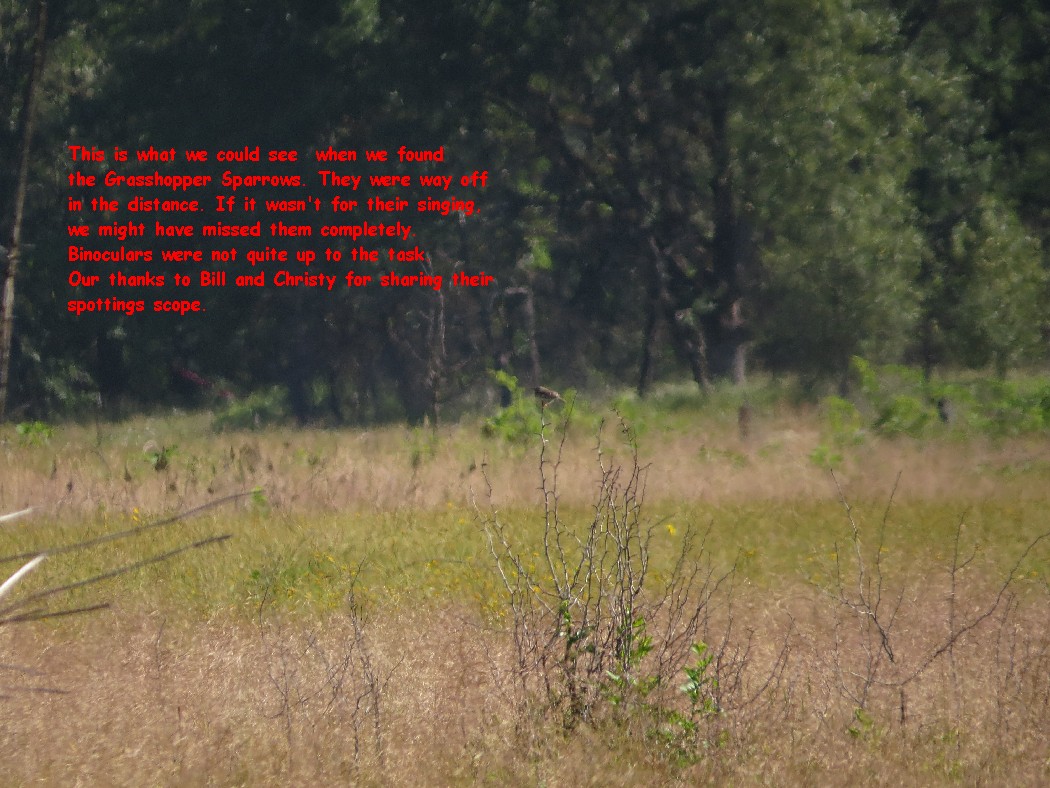



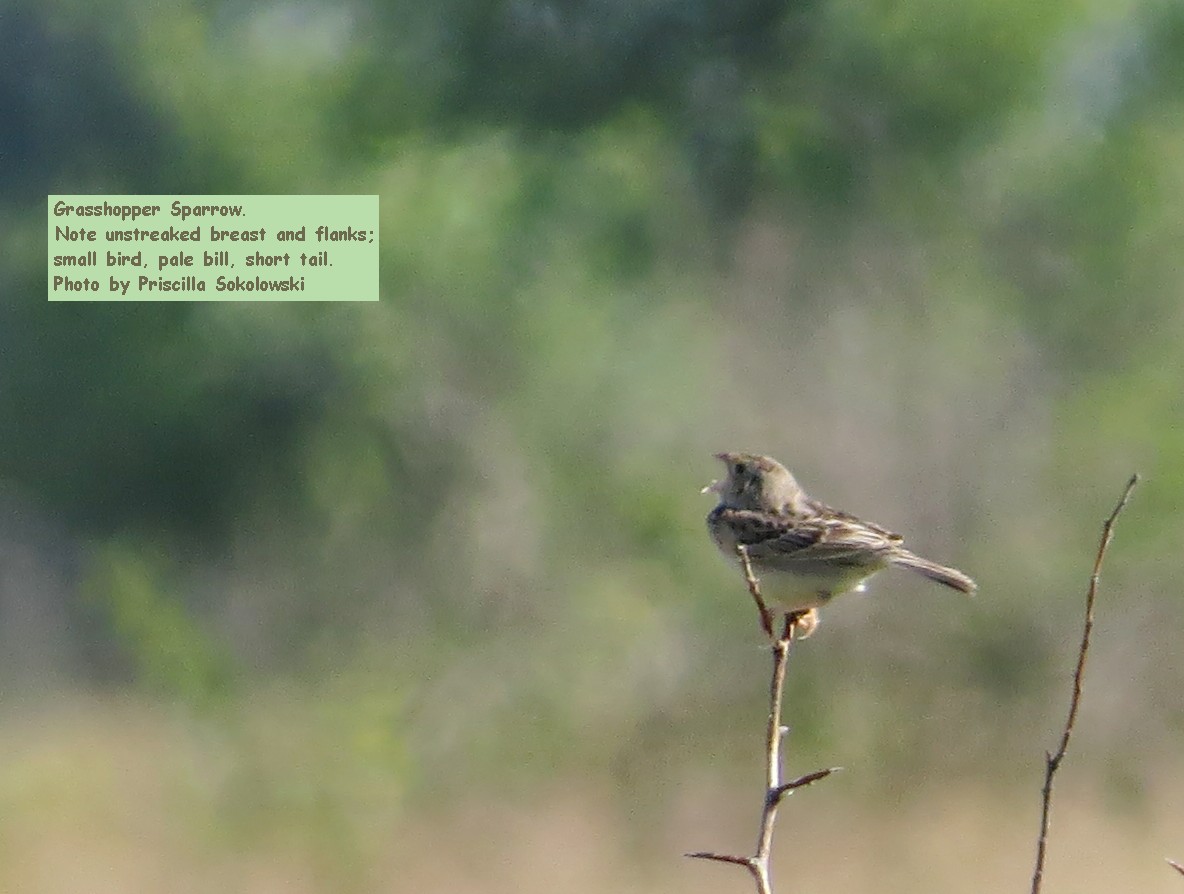

Savannah Sparrows have streaking on their upper breasts and along their flanks.
Savannahs also have pink bills and pink legs, while the Grasshopper Sparrow
has a pale bill and legs. Both species share faint yellow lores between
the bill and the eyes and a narrow white stripe down the middle of the crown.
The absence of any streaking on flanks or breast was our best field mark.
I never have gotten around to checking the field guides, to see if there are
any other un-streaked birds which might also be out there. If there aren't,
then we can be confident we saw what we would all like to think we saw.


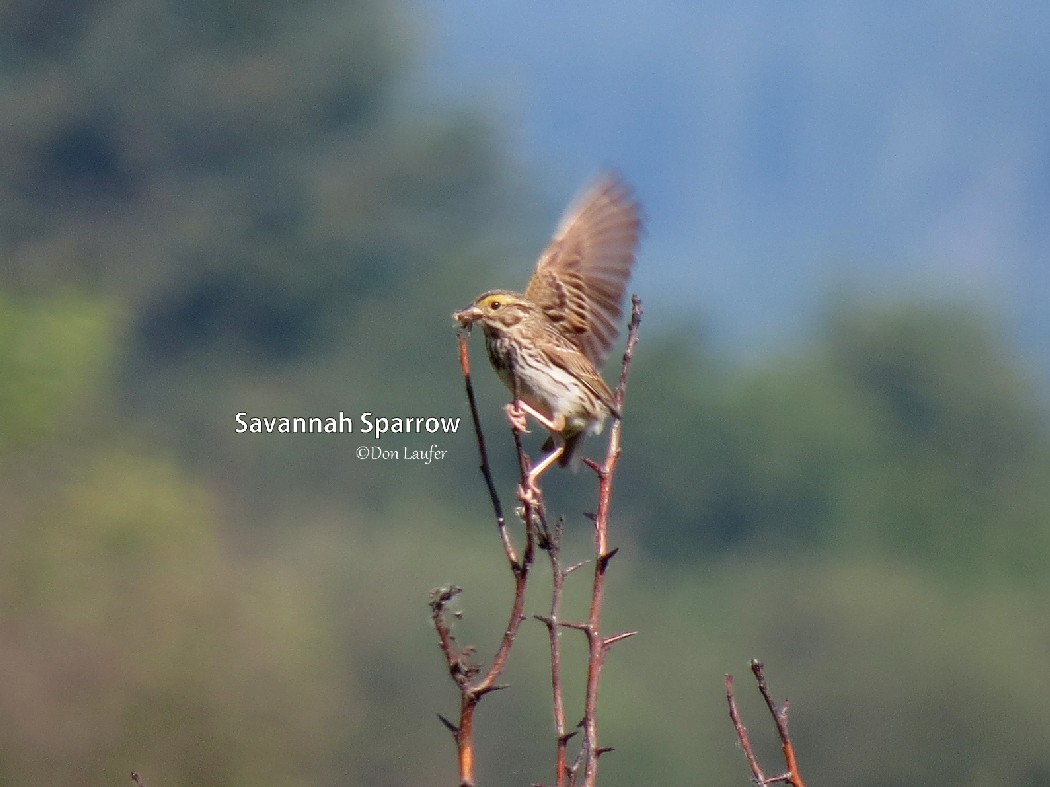



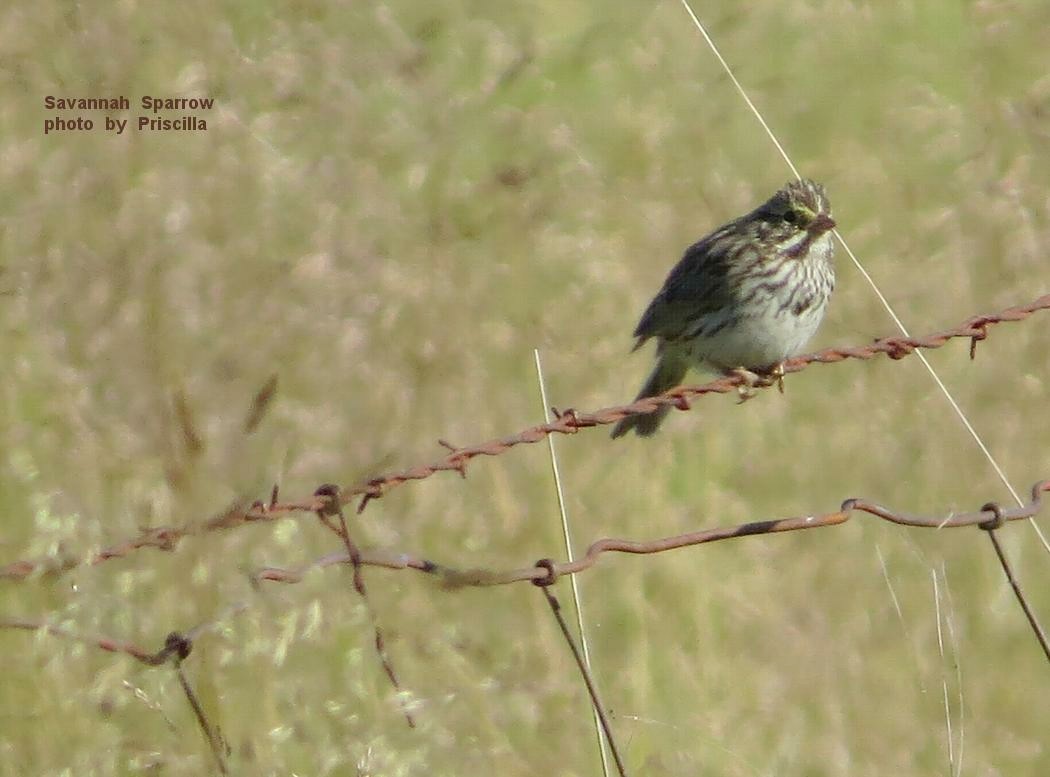

The trail followed a fenced private field north maybe 1/8 mile,
and then east a greater distance. It ran alongside a shallow drainage dish,
long since dried up, and which made easier walking at times. We heard, saw
and photographed a few more Grasshopper Sparrows along the way. One of them
confused us because it had some streaking up the upper breast. We thought it
might be a juvenile Grasshopper Sparrow.
At the eastern-most point of this part of the walk we came to the back end (north end)
of the stand of White Oak trees which we commonly refer to as the "Acorn Woodpecker Patch.
We are normally on Royal Ave when we stop to look for Acorn Woodpeckers in this stand
of trees, but today we were about an 1/8 mile north and on the northestern edge
of this patch. A thin "line" of these trees continued further northwest, at some point
we turned north and happened to be walking along them.
In this area, some folks did hear an Acorn Woodpecker or two but as far as I know,
no one caught sight of them. What was most pronounced was the incessant calling of
Western Wood Pewees in this area. These were really hard to see for some reason, but we did finally get some good views of a few of these birds.
Several nice photos were taken too.
In the collage of photos below, the Olive-sided Flycatcher photos were taken by Don Laufer on the Klamath Falls trip. I am using them here to make comparisons with
the Western Wood Pewee. In good lighting the dark, open vest of the Olive-sided is a very good field mark. The breast of the Wood Pewee varies from bird to bird somewhat,
but is generally lighter in color along the flanks, even on those occassions when it appears to have something of a vest.

The wing length comparison is even more dramatic and more important too, when dealing with a Willow Flycatcher vs a Western Wood Pewee. The Willow Flycatcher
looks much more like a Pewee than the Olive-sided does. But the Willow Flycatcher has very short wings, which only reach to the very base of the tail. Of course
if they sing, you have it made, with their two-syllable "fitz-bew" vs the single breezy "peeer" of the Pewee. We have yet to get a good look and good photographs
of a Willow Flycatcher on our BOGS walks in recent years, but one of these days it will happen.




In fact we had turned north without realizing we were no longer following the trail.
Instead, we were following a drainage path. We only figured this out later
after finding ourselves plodding extremely slowly through very clumpy hardened soil
with deep pocket-holes in it; probably cattle tracks made in soft mud
and now long hardened. With so many of us getting up in years, I worried about
us navigating our way through this. Some of the more intrepid hikers went ahead of the main group and found
the trail about 200 feet east of where the rest of us were still making our way precariously through the pock-marked field.
Somewhere along the way, Donna found a small rodent or bat skull. None of us were skilled at deciphering this sort of thing, so we took some photographs and Janet showed them
to several people more qualified to work out what it was. However, she wrote back telling me that no one was able identify the critter.


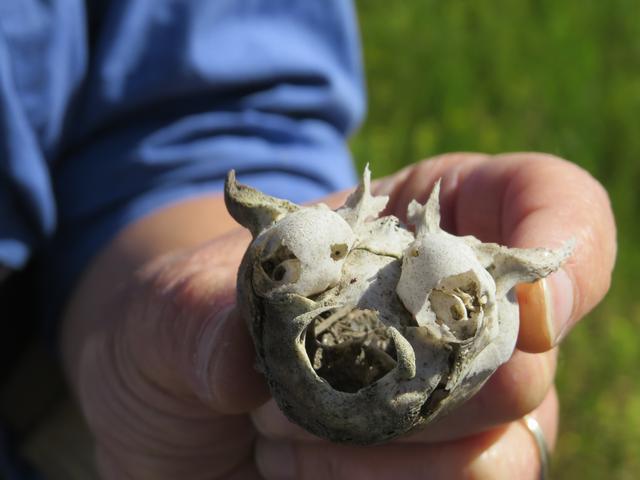

Once we got back on the trail, we came across an old much-weathered sign which was barely readable. It was not late in the morning yet, maybe only 10am
so some members wanted to continue further north. I would like to have done that as well, but I was not sure that the trail we had found would take us back
to the one on which we began. I needed to know if we were going to have to plod through more dangerous terrain again, and I wanted to find that out before we got ourselves tired out and out of time.
Besides, a good sized fraction of our group had very sensibly turned around when we first got into the really rough ground. So we turned back south, and as it happened, there were no
more challenging sections after all.


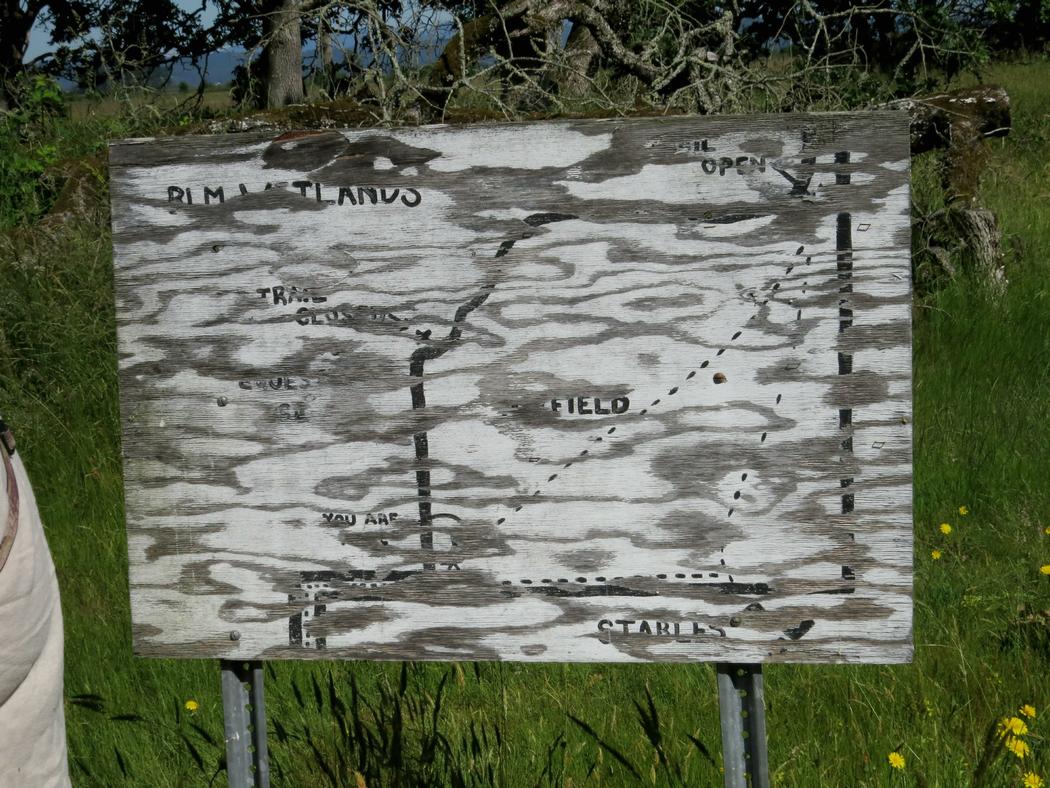

Not too much happened on the way back to the cars. We saw a Meadowlark which looked kind of Frankenstein-ish because while it had a yellow throat,
below that point there was no yellow at all. We thought it must be a juvenile bird, though it was singing continuously.
Marylee thought she had a quick glimpse of a Black-Throated Sparrow at the base of a small tree surrounded by dense bushes and blackberries.
This bird is very conspicuous with its huge black throat and bib against a white breast, its brilliant white stripe above the eye and another white stripe
extending down from the sides of the bill. No one would be likely to confuse this bird with anything else in our area. Several of us saw a Spotted Towhee
in the same area, but there is no comparison between the two really. No one else saw the bird Marylee saw.
A month earlier there had been a Black-throated Sparrow in this very same area. First reported to OBOL by Alan Contreras, it was then seen by Mark Nikas and Sally Hil,
who added their sighting to OBOL. Barbara Combs posted her sighting of the bird in eBird the same day. So did Eddie and Vjera Thompson, Mary Lynn Scattaregia,
Adrian and Christopher Hinkle. None of this last group posted to OBOL, probably because the bird had been reported that same day already by three others.
I mention this because birders are a widely disparate group when it comes to their reporting of sightings.
There are some birders who do not post to eBird but who post regularly to OBOL, while there are other birders who post to eBird
but not to OBOL. A few people I've met in the field do not post their sightings anywhere. (I personally only post my sightings
of particularly uncommon birds and in those cases I post to both places).
I've noticed the Corvallis Audubon folks especially tend to follow this second pattern; (posting to eBird, but not so much to OBOL).
They have some of the highest eBird posting rates (per capita) in Western Oregon, and probably over all of Oregon. (I saw that on an eBird webpage someplace).
Of course there are many birders whose names show up every week in both places.( I check both OBOL and eBird nearly every day).
I have noticed that sometimes eBird has reports of sightings which don't find their way into OBOL. This happens mostly with birds
which, while not considered rare, are not every-day birds either. Yellow-breasted Chats are a good example which comes to mind. It is also especially true for Owl sightings.
Quite a few birders do not want to publicize the locations of Owls, especially ground dwelling Burrowing Owls. But I've seen it with Short-eared Owls as well.
Some of you may not know that we had two wintering Burrowing Owls killed (shot) near the Eugene airport back around the 1970s.
Since no Burrowing Owls have been reported at our end of the valley since that time, these bitter memories do not quickly fade.
The next day Allen Prigge posted to OBOL that he found the Black-throated Sparrow. It was only seen on those two sequential days, May 17 and 18.
The Wednesday morning birding group made efforts to find it on the 20th but did not see it.
As I told Marylee at the time, a lot of good birders go out into the Hansen See-Sil area, especially when the trails are not flooded, so if that bird is still around, someone is likely to see it again
and we will hear about it. Sadly, it's been more than a month now, and that has not happened.

From there, it was down to a pair of adult Bald Eagles soaring high above us,
a Turkey Vulture or two, and otherwise more of what we had seen on the way in.
This was an enjoyable first Summer bird walk, and we were successful at finding the Grasshopper
Sparrows which few of us had seen before.
The photo slide-show for this trip can be found here:
http://priscillanhk.com/bogs-hansen-see-sil-6-11-15.html
Generally if you want to know what is happening next at BOGS, or want to see links to the latest photos/reports,
you can find these on my "updates" page:
http://priscillanhk.com/updates.html
Enjoy!
Priscilla















